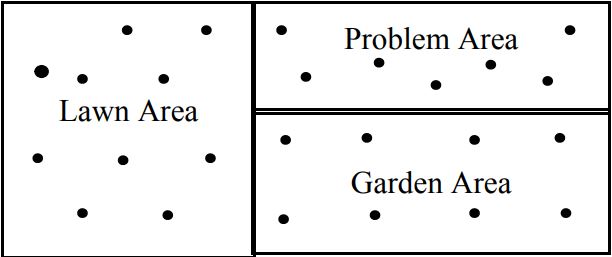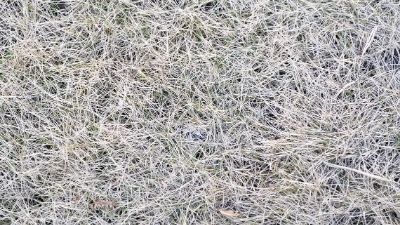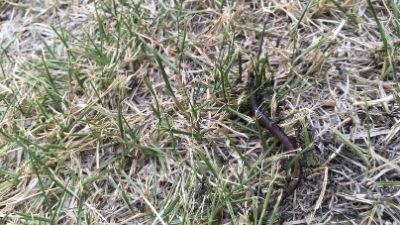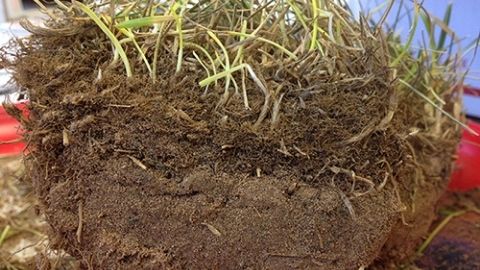Growing Turf on Salt-Affected Sites

In many areas of Utah, high salt levels in the soil limit the growth of some turfgrasses, especially Kentucky bluegrass. This fact sheet was written to assist you in determining if you have a soil with a high salt level and, if you do, how to manage it with the use of irrigation, drainage, and salt tolerant grasses. We also list some alternative turfgrasses that do well on saltaffected soils.
How a Salt Problem Develops
Salts are a common and needed part of the soil, and many salts (e.g., nitrates andpotassium) are essential plant nutrients. But, they can become concentrated from natural processes and mismanagement. In any part of the world where evaporation from the ground is greater than the rainfall, salts tend to accumulate. This is the case in many areas of Utah where the total precipitation is less than 10 inches per year. This problem is compounded by poor irrigation practices. Salty, or saline, soils can also develop because of poor soil drainage, a high water table, and the use of poor quality (salty) irrigation water. Also, ice melters applied to roads and sidewalks during the winter add a significant amount of salt to soil. A saline soil is classified as a soil containing enough soluble salts to impair its productivity for plant growth, but does not contain an excess of exchangeable sodium.
As salinity levels increase, turfgrasses extract water less easily from soil, aggravating drought conditions. High soil salinity can also cause nutrient imbalances and reduce water infiltration if the level of one salt element - sodium - is high. A soil that contains sufficient exchangeable sodium to interfere with the growth of most plants, either with or without appreciable quantities of soluble salts, is called a sodic soil.
In cases where soils are poorly drained, because of an impermeable layer or impermeable topsoil, salts accumulate near the soil surface. Soils that have high enough levels of soluble salts to affect plant growth are classified as saline. Saline soils may be recognized by white crusts on high spots, salt burned leaves, stunted plants or spotty stands of grass, but these symptoms are not always obvious.
Salinity Measurement
It is critical to know the salt levels of the soil before you select the turfgrass species to be grown on the site. The only way to know this information is to take a properly acquired soil sample to a certified lab and have it analyzed for salt levels. To obtain a soil sample of an area to be tested for salinity, divide the site into different areas depending on variations in soil conditions, historic fertilizer and soil amendment applications, or other management differences. For landscapes, this means that garden areas, turf, and planting beds should be sampled separately. Problem areas within a landscape should also be sampled separately for diagnostic purposes.

The most efficient way to collect samples is with a hollow tube soil probe. Soils where turf will be grown should be sampled to a depth of 6 inches. Many Extension offices have soil probes and may lend them to homeowners to take a
soil sample. A minimum of six to twelve sub samples should be collected from each area sampled and then combined together into one composite sample for analysis (Figure 1). This ensures that the sample submitted is representative of the area. Remember, the soil test results will only be as good as the sample. A shovel can also be used to collect soil samples but is not recommended because it disturbs the turfgrass and the results are less accurate. County Extension offices and the Utah State University Analytical Laboratory (phone: 435-797-2217) have sample kits available which include additional instructions on how to collect soil samples, a site information form used by the lab to interpret soil test results, and a box for mailing soil samples. A soil test for salinity typically costs $5.00 - $7.50 per sample and is a small investment relative to the cost of turfgrass seed, hydro seeding or sodding landscapes. For an additional fee, the laboratory will also test your soil for nutrient content and give you recommendations
Table 1. Soil salinity levels for turfgrass
| Soil Salinity Tolerance | ECₑ |
|---|---|
| Very sensitive plants can tolerate | < 1.5 |
| Moderate sensitive plants must be used | 1.6 - 3.0 |
| Moderate tolerant plants must be used | 3.1 - 6.0 |
| Tolerant plants must be used | 6.1 - 10.0 |
| Very tolerant plants must be used | > 10.0 |
Table is from Carrow, R, N, and R, R, Duncan. 1998. Salt affected turfgrass sites: assessment and management. Ann Arbor Press, Chelsea, Michigan.
Soil salinity is determined by measuring the electrical conductivity of a solution extracted from the soil sample. Salinity from the analysis is abbreviated as ECe (Electrical Conductivity of the extract) with units of deci-siemens per meter (dS/m) or millimhos per centimeter (mmhos/cm). Both are equivalent units of measurement and give the same numerical value for comparing turfgrass tolerance to salinity. Table 1 gives examples of general soil salinity tolerance levels for turfgrasses.
Managing Salinity Problems
Saline soils will not necessarily prevent you from growing a nice lawn. However, special management techniques or choice of turfgrass species may be required to grow a lawn on salt affected sites.
Irrigation Management
Salt is like a hitchhiker that goes wherever water goes. To manage salt, you must manage the movement of water in the soil. Proper irrigation can often help improve saline soils, provided the area has good internal drainage; i.e., the water moves down through the soil rather than running off the surface. THIS IS VERY IMPORTANT since proper irrigation management is essential to prevent further salinity problems. Where high ground water tables are present, salts move upward with the water through the finer capillary pores and accumulate as water evaporates. As the soil dries, salts become concentrated near the soil surface and increase salt stress. This is why salt problems are more severe under hot and dry conditions than under cool and humid conditions. However, when you have a rainy or monsoon season in the summer, which, in the desert, is also the hot time of the year, salt stress can be more prevalent in winter, spring and fall. Also, because the growing and the irrigation seasons are during the summer months, salt accumulation and salt stress from a capillary rise can be severe in the winter if there is no or very little snow fall. During hot, dry periods, one may need to increase irrigation frequency and applying water in excess of plant demand if the water is of poor quality or if the soil is high in salts, to minimize salinity stress. Research has shown that by applying large volumes of water, you may be able to reduce the salt level of the soil. Table 2 gives the approximate amount of water needed to reduce salt levels in soils. The manner in which this water is applied is
important. Water must drain through the soil rather than run off the surface. Sprinkler irrigation systems generally allow better control of water application rates; however, flood irrigation can be used if sites are level and water application is controlled. After applying large volumes of water to the site, test the soil again to determine whether salinity levels are now suitable for the type of grass you would like to plant.
Table 2. Amount of water needed to reduce salt levels in soils.
| Water Applied | Percent Reduction |
|---|---|
| 6 inches | 50% |
| 12 inches | 80% |
| 24 inches | 90% |
“White alkali” (soluble salts) seen in many areas of the state are chlorides, sulfates, carbonates and sometimes nitrates of calcium, magnesium, potassium and other minerals. These salts are mostly soluble. They can be leached out of soils with good internal drainage when good quality irrigation water is used.
In soils where sodium constitutes a significant amount of the salts found in the soil or in the irrigation water, additions of gypsum or sulfur may be necessary. The calcium in gypsum, or in the gypsum produced by the addition of sulfur, replaces the sodium on the soil particles and allows water to move the sodium below the rootzone. A more in-depth soil test for a sodium absorption ratio (SAR) will indicate the need for amendments such as gypsum and sulfur.
Improving Internal Drainage
Washing salts off the soil surface is not sufficient to prevent damage to grass roots. Internal and adequate drainage (either natural or man-made) is usually necessary to allow leaching of salts below the root system of the grass. Sometimes a layer of clay or compaction in the soil will prevent proper drainage. Cultivation or aeration may be required to break through such layers to increase drainage and the downward movement of salts.Salt problems are generally more serious in heavy clay soils where adequate drainage does not exist. Adding good quality organic matter at the rate of three to six cubic yards per 1,000 square foot area before establishment of the turfgrass, and thoroughly mixing this with the existing soil to a depth of at least 6 inches, can improve drainage. Avoid, however, the excessive use of cow or steer manure because it may already be high in salts. Horse manure is often mixed with straw, hay or wood chips. These materials resist rapid decomposition and consequently improve internal drainage longer than cow manure or other fine materials.
Adding sand by itself as a soil amendment to loosen clay soils is seldom recommended. Sand mixed with heavy clay soil frequently sets up like concrete. However, sand may be used with a good quality compost to enhance drainage.
A high water table, 48 inches or less below the surface, can aggravate a soluble salt problem and create a hydraulic connection with the soil surface. This allows the “pumping” of soluble salt to the soil surface. If an outlet is available, use a tile drain system to reduce a high water table problem. In addition, place a layer of coarse sand above the water table and below a layer of good, loamy soil to stop upward water and salt movement.
In many instances, it may not be practical to amend, drain and leach the soil for growing a salt sensitive turfgrass like Kentucky bluegrass. In these areas, a salt-tolerant grass may provide an acceptable solution. This is especially true where a lawn is in a low, poorly drained area where a high water table exists, or when salt moves from an unlined irrigation ditch into a lawn area. There are some areas in Utah where the combination of high salts and heavy clay soils preclude the planting of any turf variety without excessive costs.
Turfgrasses for Salty Sites
There are many alternative turfgrasses that will give good quality lawns on salty sites. An inexpensive soil test will help you determine the salt level in the soil and enable you to select the appropriate species for the salt-affected site (Table 3). Less familiar, salt-tolerant grasses for home lawns are perennial ryegrass, tall fescue, fine fescue, wheatgrasses, buffalograss, blue grama, smooth bromegrass and
alkaligrass. (See Table 4 for examples of each of the varieties.) Perennial ryegrass and alkaligrass are fine-textured and should be mowed, fertilized, and watered like a Kentucky bluegrass lawn. Perennial ryegrass establishes quickly. Turf-type tall fescue and crested
wheatgrass often look coarser and are lighter green than Kentucky bluegrass; however, many new varieties of tall fescue match Kentucky bluegrass in quality. They require less fertilizer than Kentucky bluegrass and do not form a thatch layer. Tall fescue also tolerates a high water table better than most species.
Table 3. Approximate salt tolerance of turfgrass species
| Turfgrass Species | Salt Tolerance (ECₑ mmhos/cm) | Growth Habit |
|---|---|---|
| Kentucky Bluegrass | < 3 | Rhizomatous* grass |
| Buffalograss | 1 to 6 | Stoloniferous** grass |
| Blue Grama | 3 to 6 | Bunch-type grass |
| Smooth Bromegrass | 3 to 6 | Rhizomatous grass |
| Perennial Ryegrass | 6 to 10 | Bunch-type grass |
| Tall Fescue | 6 to 10 | Bunch-type grass |
| Fine Fescue | 3 to 6 | Rhizomatous grass |
| Crested Wheatgrass | 8 to 12 | Rhizomatous grass |
| Alkaligrass | > 10 | Bunch-type grass |
* Fills in by sending out below ground runners
** Fills in by sending out above ground runners
Table 4. Some varieties of salt tolerant turfgrasses*
| Common name | Variety Names |
|---|---|
| Alkaligrass | Fults, Salty |
| Blue Grama | Alma, Hachita, Lovington |
| Buffalograss | Bison, Cody, Commanche, Legacy, Texoka |
| Perennial Ryegrass | Blazer II, Calypso II, Cutter, Envy, Pinnacle, Prizm, Seville |
| Fine Fescue | Pennlawn, Vista, Shademaster |
| Tall Fescue | Austin, Coyote, Gazelle, Guardian, Mustang, Rebel II, Shenandoah, Vegas, Water Saver |
| Crested Wheatgrass | Douglas, Ephraim, Fairway, Roadcrest |
* These are only a few of the many good varieties available.
Bermudagrass is considered a noxious weed in all counties in Utah except Washington County. Therefore, it is illegal to use this species in a lawn setting. Bermudagrass has probably the best salt tolerance level of all the grasses listed above. (If you live in another state, please check with your local Extension Service or District Agricultural Inspector to see if it may be planted in your state.)
Salty sites can be planted with a single species, or mixes of different salt-tolerant grasses. In lower salt areas, buffalograss and blue grama can be planted together, but do not mix well with other grass species. These are warm-season grasses that green up in late May and brown with the first hard frost in the fall. They should not be used above 5,500 feet in elevation.
Bromegrass, tall fescue, and crested wheatgrass can be planted as mixtures, or alone. They do not blend well with the finer-textured grasses like ryegrass or bluegrass. Plant perennial ryegrass only when the lawn will be intensively managed. It will not persist under low maintenance conditions. Fine fescue provides a dark green, fine-textured lawn and prefers driersoils. Alkaligrass looks like fine fescue, but does best where it is well-watered.
Do not confuse the turf-type tall fescues with the older pasture-types such as Alta, Fawn, Goar, Kenmont, Kentucky-31, and Kenwell. The newly developed cultivars generally are darker green, have finer and smoother leaves, and are more tolerant of shade than older cultivars.
Grasses with moderate to good salt tolerance are available in some nurseries, garden centers, and seed companies. If a mix contains grasses of different salt tolerance, grasses unable to tolerate the soil conditions will die out and those that are resistant to that particular salt level will survive.
In some areas of Utah where salts are a problem, there may be demonstration plots where you can view the salt tolerant grasses listed above. For more information, contact your USU Extension office, under the Government or County Section in your local telephone book.
Grasses for Naturalized or Low Maintenance Areas
If you would like a low maintenance lawn, select grasses that will tolerate infrequentmowing and low fertilizer and irrigation applications. Wheatgrasses (tall, western, and crested), red fescue, and tall fescue all do well if left unmowed. They will become clumpy and look less “turf-like” under reduced maintenance, but will persist and provide a good soil cover. Without irrigation, these grasses become dormant during extended drought. Bromegrass can be used alone or with the above species if soil salt levels are only moderately high. Where salt levels are relatively low, blue grama and buffalograss are excellent choices for naturalized or low maintenance lawns. Never plant Kentucky bluegrass and perennial ryegrass where reduced maintenance practices are used. They will not persist without regular mowing, fertilization and irrigation.
Other related factsheets are available at extension.usu.edu.
References
- Swift, C.E. and Koski, A.J. Growing Turf on Salt-Affected Sites. No. 7.227, Colorado State University Cooperative Extension Service.
- Kotuby-Amacher, J. Koenig, R. and Kitchen, B. Salinity and Plant Tolerance. AG-SO-03, Utah State University Extension Service.
- Kotuby-Amacher, J and Koenig, R. Frequently Asked Questions About Soil Testing. HG-513, Utah State University Extension Service.
Utah State University Extension
Peer-reviewed fact sheet
Download PDF
Authors
Michael Pace, Millard County Extension Agent; Paul Johnson, Assistant Professor, Turfgrass Science
Related Research








